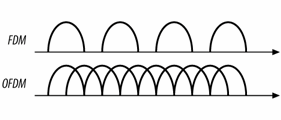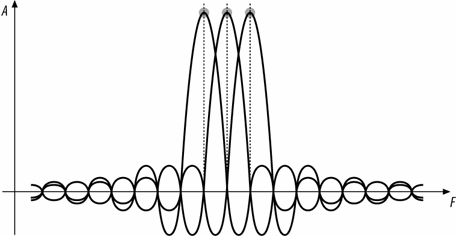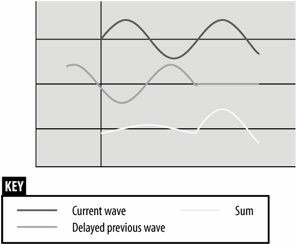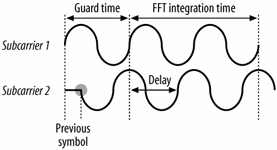Orthogonal Frequency Division Multiplexing (OFDM)
802.11a is based on orthogonal frequency division multiplexing (OFDM). OFDM is not a new technique. Most of the fundamental work was done in the late 1960s, and U.S. patent number 3,488,445 was issued in January 1970. Recent DSL work (HDSL, VDSL, and ADSL) and wireless data applications have rekindled interest in OFDM, especially now that better signal-processing techniques make it more practical.[*] OFDM does, however, differ from other emerging encoding techniques such as code division multiple access (CDMA) in its approach. CDMA uses complex mathematical transforms to put multiple transmissions onto a single carrier; OFDM encodes a single transmission into multiple subcarriers. The mathematics underlying the code division in CDMA is far more complicated than in OFDM.
[*] The lack of interest in OFDM means that references on it are sparse. Readers interested in the mathematical background that is omitted in this chapter should consult OFDM for Wireless Multimedia Applications by Richard van Nee and Ramjee Prasad (Artech House, 2000).
OFDM devices use one wide-frequency channel by breaking it up into several component subchannels. Each subchannel is used to transmit data. All the "slow" subchannels are then multiplexed into one "fast" combined channel.
Carrier Multiplexing
When network managers solicit user input on network build-outs, one of the most common demands is for more speed. The hunger for increased data transmissions has driven a host of technologies to increase speed. OFDM takes a qualitatively similar approach to Multilink PPP: when one link isn't enough, use several in parallel.
OFDM is closely related to plain old frequency division multiplexing (FDM). Both divide the available bandwidth into slices called carriers or subcarriers and make those carriers available as distinct channels for data transmission. OFDM boosts throughput by using several subcarriers in parallel and multiplexing data over the set of subcarriers.
Traditional FDM was widely used by first-generation mobile telephones as a method for radio channel allocation. Each user was given an exclusive channel, and guard bands were used to ensure that spectral leakage from one user did not cause problems for users of adjacent channels. Figure 13-1 illustrates the traditional FDM approach.
The trouble with traditional FDM is that the guard bands waste bandwidth and thus reduce capacity. To avoid wasting transmission capacity with unused guard bands, OFDM selects channels that overlap but do not interfere with each other. Figure 13-2 illustrates the contrast between traditional FDM and OFDM.
Figure 13-1. Traditional FDM

Figure 13-2. FDM versus OFDM

Overlapping carriers are allowed because the subcarriers are defined so that they are easily distinguished from one another. The ability to separate the subcarriers hinges on a complex mathematical relationship called orthogonality.
Orthogonality Explained (Without Calculus)
Orthogonal is a mathematical term derived from the Greek word orthos, meaning straight, right, or true. In mathematics, the word "orthogonal" is used to describe independent items. Orthogonality is best seen in the frequency domain, looking at a spectral breakdown of a signal. OFDM works because the frequencies of the subcarriers are selected so that at each subcarrier frequency, all other subcarriers do not contribute to the overall waveform. One common way of looking at orthogonality is shown in Figure 13-3. The signal has been divided into its three subcarriers. The peak of each subcarrier, shown by the heavy dot at the top, encodes data. The subcarrier set is carefully designed to be orthogonal; note that at the peak of each of the subcarriers, the other two subcarriers have zero amplitude.
OFDM takes the coded signal for each subchannel and uses the inverse fast Fourier transform (IFFT) to create a composite waveform from the strength of each subchannel. OFDM receivers can then apply the FFT to a received waveform to extract the amplitude of each component subcarrier.
Guard Time
With the physical layers discussed in Chapter 12, the main problem for receivers was inter-symbol interference (ISI) (Figure 13-4). ISI occurs when the delay spread between different paths is large and causes a delayed copy of the transmitted bits to shift onto a previously arrived copy.
Figure 13-3. Orthogonality in the frequency domain

Figure 13-4. ISI reviewed

With OFDM, inter-symbol interference does not pose the same kind of problem. The Fourier transform used by OFDM distills the received waveform into the strengths of the subcarriers, so time shifts do not cause dramatic problems. In Figure 13-4, there would be a strong peak for the fundamental low-frequency carrier, and the late-arriving high-frequency component could be ignored.
As with all benefits, however, there is a price to pay. OFDM systems use multiple subcarriers of different frequencies. The subcarriers are packed tightly into an operating channel, and small shifts in subcarrier frequencies may cause interference between carriers, a phenomenon called inter-carrier interference (ICI). Frequency shifts may occur because of the Doppler effect or because there is a slight difference between the transmitter and receiver clock frequencies.
To address both ISI and ICI, OFDM transceivers reserve the beginning portion of the symbol time as the guard time and perform the Fourier transform only on the non-guard time portion of the symbol time. The non-guard time portion of the symbol is often called the FFT integration time because the Fourier transform is performed only on that portion of the symbol.
Delays shorter than the guard time do not cause ICI because they do not allow frequency components to leak into successive symbol times. Selecting the guard time is a major task for designers of OFDM systems. The guard time obviously reduces the overall throughput of the system because it reduces the time during which data transmission is allowed. A guard time that is too short does not prevent interference but does reduce throughput, and a guard time that is too long reduces throughput unnecessarily.
Cyclic Extensions (Cyclic Prefixes)
The most straightforward method of implementing the guard time would be simply to transmit nothing during the guard time, as shown in Figure 13-5.
Figure 13-5. Naive implementation of guard time (do not do this!)

Simplistic implementations of the guard time can destroy orthogonality in the presence of common delay spreads. OFDM depends on having an integer number of wavelengths between each of the carriers. When the guard time is perfectly quiet, it is easy to see how a delay can destroy this necessary precondition, as in Figure 13-5. When the two subcarriers are added together, the spectral analysis shows subcarrier 1 (two cycles/symbol) as a strong opdpresence and a relatively smaller amount of subcarrier 2 (three cycles/symbol). In addition, the spectral analysis shows a large number of high-frequency components, muddying the waters further. These components are the consequence of suddenly turning a signal "on."
Solving the problems associated with a quiet guard time is quite simple. Each subcarrier is extended through the FFT integration period back through the preceding guard time. Extending each subcarrier (and hence the entire OFDM symbol) yields a Fourier transform that shows only the amplitudes of the subcarrier frequencies. This technique is commonly called cyclic extension, and it may be referred to as the "cyclic prefix extension." The guard time with the extended prefix is called the cyclic prefix.
In Figure 13-6, the cyclic prefix preserves the spectral analysis. Subcarrier 1 was not shifted and is not a problem. Subcarrier 2 is delayed, but the previous symbol appears only in the guard time and is not processed by the Fourier transform. Thanks to the cyclic prefix extension, when subcarrier 2 is processed by the Fourier transform, it is a pure wave at three cycles per integration time.
Figure 13-6. Cyclic prefix extension

Windowing
One further enhancement helps OFDM transceivers cope with real-world effects. Transitions can be abrupt at symbol boundaries, causing a large number of high-frequency components (noise). To make OFDM transmitters good radio citizens, it is common to add padding bits at the beginning and end of transmissions to allow transmitters to "ramp up" and "ramp down" from full power. Padding bits are frequently needed when error correction coding is used. Some documentation may refer to the padding as "training sequences."
Windowing is a technique used to bring the signal for a new symbol gradually up to full strength while allowing the old symbol to fade away. Figure 13-7 shows a common windowing function based on a cosine curve. At the start of the symbol period, the new function is brought up to full strength according to the cosine function. When the symbol ends, the cosine curve is used to fade out the bits at the end of the symbol.
Figure 13-7. Cosine windowing technique

Introduction to Wireless Networking
- Introduction to Wireless Networking
- Why Wireless?
- What Makes Wireless Networks Different
- A Network by Any Other Name...
Overview of 802.11 Networks
- Overview of 802.11 Networks
- IEEE 802 Network Technology Family Tree
- 11 Nomenclature and Design
- 11 Network Operations
- Mobility Support
11 MAC Fundamentals
- 11 MAC Fundamentals
- Challenges for the MAC
- MAC Access Modes and Timing
- Contention-Based Access Using the DCF
- Fragmentation and Reassembly
- Frame Format
- Encapsulation of Higher-Layer Protocols Within 802.11
- Contention-Based Data Service
- Frame Processing and Bridging
11 Framing in Detail
- 11 Framing in Detail
- Data Frames
- Control Frames
- Management Frames
- Frame Transmission and Association and Authentication States
Wired Equivalent Privacy (WEP)
- Wired Equivalent Privacy (WEP)
- Cryptographic Background to WEP
- WEP Cryptographic Operations
- Problems with WEP
- Dynamic WEP
User Authentication with 802.1X
- User Authentication with 802.1X
- The Extensible Authentication Protocol
- EAP Methods
- 1X: Network Port Authentication
- 1X on Wireless LANs
11i: Robust Security Networks, TKIP, and CCMP
- 11i: Robust Security Networks, TKIP, and CCMP
- The Temporal Key Integrity Protocol (TKIP)
- Counter Mode with CBC-MAC (CCMP)
- Robust Security Network (RSN) Operations
Management Operations
- Management Operations
- Management Architecture
- Scanning
- Authentication
- Preauthentication
- Association
- Power Conservation
- Timer Synchronization
- Spectrum Management
Contention-Free Service with the PCF
- Contention-Free Service with the PCF
- Contention-Free Access Using the PCF
- Detailed PCF Framing
- Power Management and the PCF
Physical Layer Overview
- Physical Layer Overview
- Physical-Layer Architecture
- The Radio Link
- RF Propagation with 802.11
- RF Engineering for 802.11
The Frequency-Hopping (FH) PHY
- The Frequency-Hopping (FH) PHY
- Frequency-Hopping Transmission
- Gaussian Frequency Shift Keying (GFSK)
- FH PHY Convergence Procedure (PLCP)
- Frequency-Hopping PMD Sublayer
- Characteristics of the FH PHY
The Direct Sequence PHYs: DSSS and HR/DSSS (802.11b)
- The Direct Sequence PHYs: DSSS and HR/DSSS (802.11b)
- Direct Sequence Transmission
- Differential Phase Shift Keying (DPSK)
- The Original Direct Sequence PHY
- Complementary Code Keying
- High Rate Direct Sequence PHY
11a and 802.11j: 5-GHz OFDM PHY
- 11a and 802.11j: 5-GHz OFDM PHY
- Orthogonal Frequency Division Multiplexing (OFDM)
- OFDM as Applied by 802.11a
- OFDM PLCP
- OFDM PMD
- Characteristics of the OFDM PHY
11g: The Extended-Rate PHY (ERP)
- 11g: The Extended-Rate PHY (ERP)
- 11g Components
- ERP Physical Layer Convergence (PLCP)
- ERP Physical Medium Dependent (PMD) Layer
A Peek Ahead at 802.11n: MIMO-OFDM
11 Hardware
- 11 Hardware
- General Structure of an 802.11 Interface
- Implementation-Specific Behavior
- Reading the Specification Sheet
Using 802.11 on Windows
11 on the Macintosh
Using 802.11 on Linux
- Using 802.11 on Linux
- PCMCIA Support on Linux
- Linux Wireless Extensions and Tools
- Agere (Lucent) Orinoco
- Atheros-Based cards and MADwifi
- 1X on Linux with xsupplicant
Using 802.11 Access Points
- Using 802.11 Access Points
- General Functions of an Access Point
- Power over Ethernet (PoE)
- Selecting Access Points
- Cisco 1200 Access Point
- Apple AirPort
Logical Wireless Network Architecture
- Logical Wireless Network Architecture
- Evaluating a Logical Architecture
- Topology Examples
- Choosing Your Logical Architecture
Security Architecture
- Security Architecture
- Security Definition and Analysis
- Authentication and Access Control
- Ensuring Secrecy Through Encryption
- Selecting Security Protocols
- Rogue Access Points
Site Planning and Project Management
- Site Planning and Project Management
- Project Planning and Requirements
- Network Requirements
- Physical Layer Selection and Design
- Planning Access-Point Placement
- Using Antennas to Tailor Coverage
11 Network Analysis
11 Performance Tuning
Conclusions and Predictions
EAN: 2147483647
Pages: 179
